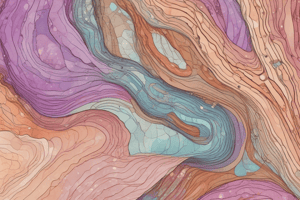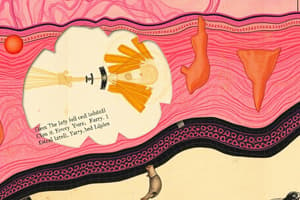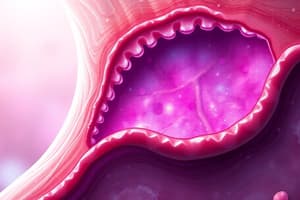Podcast
Questions and Answers
What is the primary type of cell found in the stratum corneum of thick skin?
What is the primary type of cell found in the stratum corneum of thick skin?
- Langerhans cells
- Keratinocytes (correct)
- Melanocytes
- Merkel's cells
Which layer of the epidermis is characterized by intense mitotic activity?
Which layer of the epidermis is characterized by intense mitotic activity?
- Stratum Basale (correct)
- Stratum Corneum
- Stratum Granulosum
- Stratum Lucidum
What distinguishes thick skin from thin (hairy) skin?
What distinguishes thick skin from thin (hairy) skin?
- Thickness of the epidermis (correct)
- Types of skin receptors
- Presence of blood vessels
- Type of connective tissue
Which cell type is primarily responsible for melanin production in the epidermis?
Which cell type is primarily responsible for melanin production in the epidermis?
What is the main function of Langerhans cells in the epidermis?
What is the main function of Langerhans cells in the epidermis?
What is the consequence of albinism in terms of melanocyte function?
What is the consequence of albinism in terms of melanocyte function?
In psoriasis, what is observed in relation to skin cell proliferation?
In psoriasis, what is observed in relation to skin cell proliferation?
Which epidermal layer is characterized by keratohyalin granules?
Which epidermal layer is characterized by keratohyalin granules?
What are Langerhans cells primarily responsible for?
What are Langerhans cells primarily responsible for?
Which layer of the dermis is formed of areolar connective tissue and contains Meissner's corpuscles?
Which layer of the dermis is formed of areolar connective tissue and contains Meissner's corpuscles?
What causes the skin to become more fragile and develop wrinkles in old age?
What causes the skin to become more fragile and develop wrinkles in old age?
What type of sweat is secreted by apocrine sweat glands?
What type of sweat is secreted by apocrine sweat glands?
Which type of hair is present in infants and is characterized by its fine, soft texture?
Which type of hair is present in infants and is characterized by its fine, soft texture?
What structural component surrounds the root of each hair?
What structural component surrounds the root of each hair?
Which type of sweat gland is NOT present on the glans penis and nail beds?
Which type of sweat gland is NOT present on the glans penis and nail beds?
What is the primary function of Merkel's cells in the skin?
What is the primary function of Merkel's cells in the skin?
What leads to the patchy loss of pigment in vitiligo?
What leads to the patchy loss of pigment in vitiligo?
Which characteristic is NOT associated with the reticular layer of the dermis?
Which characteristic is NOT associated with the reticular layer of the dermis?
What types of cells do merocrine sweat glands secrete?
What types of cells do merocrine sweat glands secrete?
Which cells are responsible for mechanoreception in the skin?
Which cells are responsible for mechanoreception in the skin?
What contributes to the development of wrinkles in aging skin?
What contributes to the development of wrinkles in aging skin?
Which characteristic defines apocrine sweat glands and their secretions?
Which characteristic defines apocrine sweat glands and their secretions?
What type of hair is characterized as soft and fine in infants?
What type of hair is characterized as soft and fine in infants?
What structure is involved in the obstruction leading to acne development?
What structure is involved in the obstruction leading to acne development?
What is the main structural difference between the stratum granulosum and the stratum lucidum?
What is the main structural difference between the stratum granulosum and the stratum lucidum?
Which factor contributes to the increase in skin cell proliferation specifically observed in psoriasis?
Which factor contributes to the increase in skin cell proliferation specifically observed in psoriasis?
What is primarily responsible for the synthesis of melanin in melanocytes?
What is primarily responsible for the synthesis of melanin in melanocytes?
In the structure of the thick skin, how are keratinocytes organized?
In the structure of the thick skin, how are keratinocytes organized?
What characterizes the cells of the stratum corneum in thick skin?
What characterizes the cells of the stratum corneum in thick skin?
What is the primary role of Merkel's cells in the epidermis?
What is the primary role of Merkel's cells in the epidermis?
What defines thin (hairy) skin as compared to thick skin?
What defines thin (hairy) skin as compared to thick skin?
Which statement is true regarding melanophores compared to melanocytes?
Which statement is true regarding melanophores compared to melanocytes?
Flashcards
Epidermis structure
Epidermis structure
The superficial, avascular layer of skin, composed of stratified squamous keratinized epithelium.
Keratinocytes function
Keratinocytes function
Make up 85%of the epidermal cells, forming keratin, and are arranged in layers.
Melanocyte function
Melanocyte function
Melanin-producing cells found in the epidermis, crucial for skin pigment.
Stratum Basale
Stratum Basale
Deepest epidermal layer, with actively dividing cells.
Signup and view all the flashcards
Stratum Corneum
Stratum Corneum
Outermost epidermal layer, composed of flattened, dead cells filled with keratin.
Signup and view all the flashcards
Thick skin location
Thick skin location
Found on palms and soles, with five epidermal layers.
Signup and view all the flashcards
Albinism cause
Albinism cause
Hereditary condition preventing melanocytes from producing melanin, impacting skin pigmentation, due to a lack of tyrosinase activity.
Signup and view all the flashcards
Melanophores characteristics
Melanophores characteristics
Melanin-containing cells that acquire melanin through phagocytosis but cannot produce it themselves. They lack tyrosinase.
Signup and view all the flashcards
Vitiligo
Vitiligo
A skin disorder causing patchy loss of pigment due to melanocyte degeneration.
Signup and view all the flashcards
Langerhans Cells
Langerhans Cells
Star-shaped antigen-presenting cells in the epidermis derived from bone marrow.
Signup and view all the flashcards
Merkel's Cells
Merkel's Cells
Mechanoreceptors in the skin that detect touch via nerve endings.
Signup and view all the flashcards
Papillary Layer (Dermis)
Papillary Layer (Dermis)
Upper layer of the dermis containing touch receptors (Meissner's corpuscles) and capillaries.
Signup and view all the flashcards
Reticular Layer (Dermis)
Reticular Layer (Dermis)
Lower layer of the dermis with dense connective tissue, collagen, and elastic fibers.
Signup and view all the flashcards
Merocrine Sweat Glands
Merocrine Sweat Glands
Throughout body (except certain areas), producing watery sweat.
Signup and view all the flashcards
Apocrine Sweat Glands
Apocrine Sweat Glands
Located in specific areas (e.g., armpits), secreting viscous sweat.
Signup and view all the flashcards
Hair Structure
Hair Structure
Composed of shaft (medulla, cortex, cuticle), root, and follicle (outer and inner sheaths).
Signup and view all the flashcards
What causes Vitiligo?
What causes Vitiligo?
Vitiligo is a skin disorder caused by the degeneration and disappearance of melanocytes, leading to patches of depigmentation.
Signup and view all the flashcards
Papillary Layer
Papillary Layer
This layer of the dermis contains a network of blood capillaries and Meissner's corpuscles, which are responsible for touch sensation.
Signup and view all the flashcards
Reticular Layer
Reticular Layer
This dense layer of the dermis contains collagen and elastic fibers, giving skin its strength and elasticity.
Signup and view all the flashcards
What are the two main layers of skin?
What are the two main layers of skin?
The skin is composed of two layers: the epidermis and the dermis. The epidermis is the superficial avascular layer, made of stratified squamous keratinized epithelium. The dermis is the deeper layer composed of connective tissue.
Signup and view all the flashcards
What is the difference between thick and thin skin?
What is the difference between thick and thin skin?
Thick skin has all five layers of the epidermis and is found on palms and soles. Thin skin has only four layers and is found on the rest of the body.
Signup and view all the flashcards
What are keratinocytes?
What are keratinocytes?
Keratinocytes are the most abundant cells in the epidermis, making up 85% of the epidermal cells. They are responsible for producing keratin, the protein that gives skin its strength and resilience.
Signup and view all the flashcards
What do melanocytes do?
What do melanocytes do?
Melanocytes are melanin-producing cells found in the epidermis. They are responsible for giving skin its color and protecting it from UV radiation.
Signup and view all the flashcards
What are Langerhans cells?
What are Langerhans cells?
Langerhans cells are specialized immune cells found in the epidermis. They act as antigen-presenting cells, helping the immune system recognize and fight off foreign invaders.
Signup and view all the flashcards
What are Merkel cells?
What are Merkel cells?
Merkel cells are sensory receptors found in the epidermis. They are responsible for detecting light touch and pressure.
Signup and view all the flashcards
What is albinism?
What is albinism?
Albinism is a genetic condition that prevents melanocytes from producing melanin. This results in a lack of pigmentation in the skin, hair, and eyes.
Signup and view all the flashcards
What are melanophores?
What are melanophores?
Melanophores are cells that contain melanin but do not produce it. They acquire melanin by phagocytosis (engulfing) from other cells.
Signup and view all the flashcardsStudy Notes
Histology 232ANAT
- Course name: Histology
- Course code: 232ANAT
- Institution: King Khalid University
The Integumentary System (Skin)
- Skin is the largest organ, comprising 16% of total body weight.
- It comprises skin and its appendages.
- It consists of epidermis (superficial, avascular) and dermis (deep, connective tissue).
- Epidermis is made of stratified squamous keratinized epithelium.
- Dermis is composed of connective tissue.
- Skin types are classified by thickness:
- Thick skin (palms and soles)
- Thin (hairy) skin (rest of the body)
Lecture Objectives
- Describe the histological features of the epidermis and dermis.
- Explain the differences between thick and thin skin.
- Identify skin receptors.
Epidermal Cells (Thick Skin)
-
Keratinocytes (85%): form layers, keratin production
-
Melanocytes: melanin production
-
Langerhans cells: antigen-presenting cells (2-8%)
-
Merkel cells: sensory receptors
-
Keratinocytes are arranged in five layers:
- Stratum basale (germinativum): single layer, high mitotic activity
- Stratum spinosum (prickle cell layer): 4-8 polyhedral cells
- Stratum granulosum (granular layer): 3-5 flattened cells, keratinohyalin granules
- Stratum lucidum (clear layer): 1-5 rows of acidophilic dead cells, keratohyaline and eleidin granules
- Stratum corneum (horny layer): 15-20 layers of flattened, acidophilic, non-nucleated cells, soft keratin
-
Psoriasis: increased proliferating cells in basal/prickle layers, decreased cycle time
Melanoctyes
- Present between stratum basale cells.
- Derived from neural crest cells.
- Synthesize melanin using tyrosinase.
- DOPA-positive
- Melanophores do not synthesize melanin; they phagocytize it.
- Albinism: hereditary inability to synthesize melanin (tyrosinase disorder).
- Vitiligo: loss of pigment due to melanocyte degeneration.
Langerhans Cells
- Star-shaped, present mainly in stratum spinosum.
- Antigen-presenting cells.
- Process antigens and present them to T lymphocytes.
Merkel Cells
- Derived from bone marrow.
- Expanded terminal discs at Merkel cell bases.
- Mechanoreceptors.
Dermis (Layers)
-
Papillary layer: areolar connective tissue, rich in capillaries, Meissner's corpuscles.
-
Reticular layer: dense reticular connective tissue, collagen and elastic fibers, wrinkles due to sun exposure, solar elastosis, acne due to sebum blockage.
-
There are sweat glands, Pacinian corpuscles and Ruffini and Krause end bulbs.
Thin Skin (Hairy Skin)
- Covers most of the body, excluding palms and soles.
- Thinner epidermis (fewer layers).
- Irregular dermal papillae.
- Contains hairs, sebaceous and sweat glands (distributed differently than thick skin).
- Sweat Glands: two types
- Merocrine: all over body (except glans penis/nail beds), clear/dark cuboidal, watery sweat
- Apocrine: axillae, pubic, perianal regions, clear/dark cuboidal, viscous sweat (starts after puberty).
Hairs
- Two types (infantile/vellus and adult/terminal).
- Shaft, root, hair follicle.
- Shaft: medulla, cortex, cuticle
- Follicle: inner/outer root sheaths, connective tissue sheath.
- Hair follicles
- Sebaceous glands: branched alveolar glands, secrete sebum.
Differences Between Thick and Thin Skin
- Thickness of the epidermis
- Presence of a stratum lucidum
- Density of dermal papillae
- Distribution and type of glands (merocrine and apocrine sweat glands)
- Presence of hair follicles and sebaceous glands
Studying That Suits You
Use AI to generate personalized quizzes and flashcards to suit your learning preferences.




